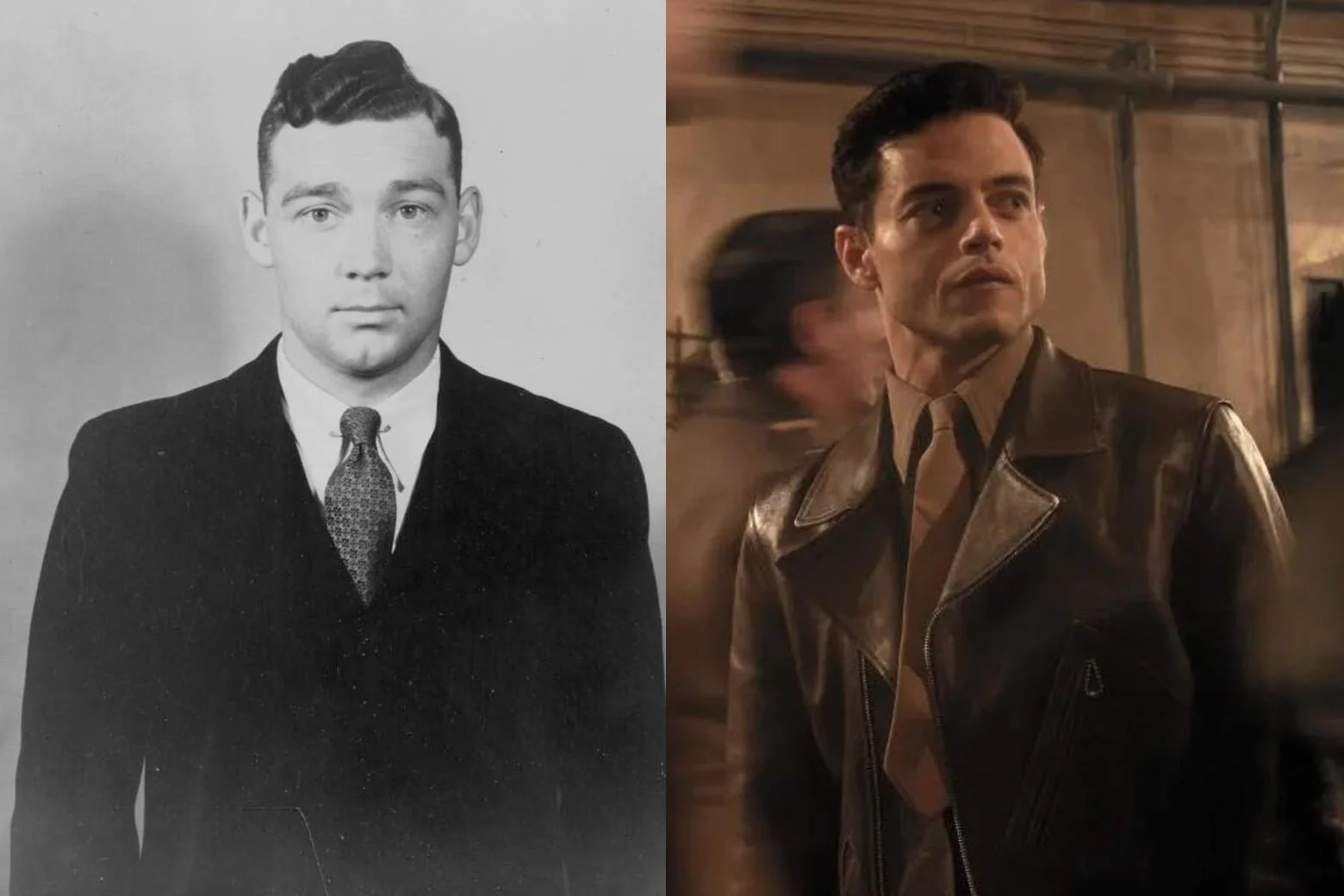Copyright Slate

The movie gods are capricious. Because it may take years, if not decades, between when a script is finished, then picked up for development, then financed for production, then made, and then finally distributed, a writer may find that her brilliant script that truly captured the zeitgeist when it was written is entirely out of date and irrelevant by the time it finally appears as a film. Alternatively, a writer might be lucky to discover that the script they wrote years ago is now even more resonant. James Vanderbilt is one such lucky writer. In 2011 he came across an article by Jack El-Hai that was to be the basis for El-Hai’s book about the relationship between the senior surviving Nazi commander Hermann Göring and Douglas Kelley, an American psychiatrist charged with determining if Göring was of sound mind before World War II’s Nuremberg war-crimes trial began. He began adapting El-Hai’s book into a script in 2013, back when the idea that the United States might question the legal basis for crimes against humanity and undermine an international order of multilateral organizations to uphold it—a structure that the U.S. had been pivotal in establishing—was unthinkable. The Nuremberg trials grew out of the Allies’ uncertainty about what to do with 22 senior Nazi officials after Germany surrendered in May 1945. Winston Churchill, with typical dispatch, wanted them executed, and Franklin Roosevelt signed a death warrant to have Göring shot. Josef Stalin wanted to hold one of the show trials that had proved so popular at home in the Soviet Union. But Supreme Court Justice and Chief U.S. Prosecutor Robert Jackson was passionately committed to a properly conducted public trial to demonstrate that power could exercise restraint, law, and judgment, as opposed to mindless vengeance. It would also, he thought, lessen the chances of the Nazi high command’s being viewed as martyrs if their atrocities were to be exposed in evidence. In order to do this, Jackson would have to develop rules of procedure and evidence for an entirely new field of law and reconcile approaches from the Allies’ four disparate judicial systems to create the International Military Tribunal, not to mention acquire and sift through enormous amounts of captured evidentiary documentation. Before the actual trials began in November 1945, the tribunal engaged a team of psychiatrists, including Kelley, to determine whether the German defendants were able to understand the proceedings and to glean insights into their personalities that could help the prosecution (as well as to ensure that they didn’t kill themselves before testifying). Thus Nuremberg the film is a hybrid, part cat-and-mouse duel of psychological manipulation (Vanderbilt has said The Silence of the Lambs was a major reference point for the script), part courtroom drama. We look at the evidence to see where the movie tells the whole truth and nothing but the truth, and where some compromises are made to assist the drama. Did Kelley Pass Letters to Göring’s Family? Over the course of their conversations, a wary rapport grows between Göring (Russell Crowe) and Kelley. The ambitious Kelley (Rami Malek) has the altruistic goal of wanting to understand why the Nazis did what they did in order to prevent it from happening again, but also the less public-spirited motivation of wanting to write a bestseller. As the astute Göring observes, “You want to be known as a great man, and I am your ticket.” Nevertheless, after Kelley weans the Nazi leader off his narcotics dependence (he arrives at the detention center with several suitcases full of opiates), Göring apparently grows to trust the doctor and asks him to deliver letters to his wife and daughter. Although it is strictly against Army regulations, Kelley takes the letters to a mountain chalet where Göring’s gemütlich wife and daughter live and is charmed by them. He starts to regularly courier letters between the prisoner and his family. But then, shortly before the trial starts, Emmy Göring is arrested by the Americans for complicity in her husband’s thefts of fine art and split up from their daughter, Edda, who is sent to a convent. When the house is searched, the letters Kelley delivered come to light. This, together with Kelley indiscreetly sharing his dim view about the preparedness of the prosecution with an attractive reporter (and these thoughts then being splashed all over a newspaper’s front page), leads to his being discharged and ordered to return to the U.S. Before he leaves, he asks for Edda and Emmy to be released and reunited, a request that is honored. Accounts differ as to the extent that Kelley delivered the letters while keeping the Army in the dark about his activities and the extent to which he had official consent. At the end of the war, Göring and his family were in their mountain home near Adolf Hitler’s retreat at Berchtesgaden. According to El-Hai, Göring claimed that when he surrendered, the Allied authorities promised him that Emmy and Edda could stay together, but by the time he was moved to the courthouse in Nuremberg in November 1945, the two had been separated, with Emmy in a civilian internment camp near Regensburg and Edda, age 7, in a nursery school in Neuhaus, near Nuremberg. Göring prevailed on Kelley to ask Gen. William “Wild Bill” Donovan, a lawyer working with Jackson who moonlighted as the founding director of the Office of Strategic Services (the precursor to the CIA) and Roosevelt’s top wartime spy, for mother and daughter to be reunited and to be allowed to deliver a letter to them. Kelley had been sharing what should have been confidential doctor-patient information with Donovan (who is not a character in the film), and the request was granted. By 1946, Emmy and Edda had been freed and were living at a family home in Neuhaus. A grateful Göring actually asked Kelley to adopt Edda if anything happened to Emmy. This suggests that only one letter was delivered, and with some official approval. However, Michael Berenbaum, a founder of the U.S. Holocaust Memorial Museum and a consultant on Schindler’s List, was Nuremberg’s historical consultant right from the first draft and maintains that Kelley frequently broke the Army’s rules by passing letters back and forth between the Görings. At any rate, Kelley did not comment on the prosecution’s failings to a minxy journalist in a bar and was not discharged ahead of time. Indeed, he was promoted. In reality, he missed his wife and was eager to start writing that possible bestseller. He was in Nuremberg for the first six weeks of the trial but returned home before Göring took the stand. Did Kelley Get Into a Fistfight With Another Doctor? After Robert Ley—one of Hitler’s inner circle who is among the 22 Nazis Kelley is responsible for keeping from sinking into depression—manages to die by suicide in his cell, Kelley learns he will be sharing his duties with a new Army psychiatrist, Gustave Gilbert (Colin Hanks), news Kelley is not at all happy to hear. When Gilbert suggests they co-author a book on the psychology of the Nazi leaders, Kelley tells him to forget it. Matters come to a head when, after Emmy is arrested, Kelley lies to Göring and conceals the information from him lest the German think Kelley has betrayed him. But then Gilbert, who is more inclined to play by the book, spills the beans, at which point the two doctors get into an undignified fistfight in the corridor. Although presented in the film as less of a maverick, Gilbert was every bit as ambitious as Kelley and similarly saw the experience of interviewing the Nazi high command as a ticket to national attention. In fact, the two originally did agree to collaborate on a book, but Kelley abruptly withdrew from the arrangement because he thought he and Gilbert were coming to different conclusions, with Kelley arguing that the Nazi leaders had a particular personality type—authoritarian, nationalistic, and prone to following strong leaders—but were not necessarily psychopaths, while Gilbert thought they were psychologically disordered, calling Göring, for example, an “intelligent but sadistic egotist” and an “aggressive psychopath.” Ironically, both Gilbert and Kelley to a great extent relied on Rorschach tests and IQ tests, two diagnostic tools that are now regarded as rather dubious in psychological circles. The relationship between the two psychiatrists turned toxic, with Gilbert suggesting that Kelley had stolen his notes before leaving Nuremberg. It didn’t help that Kelley was already negotiating with publishers about a book and wrote to Gilbert to request “more interviews and transcripts from the trial.” Worse, on returning to the U.S., Kelley started giving interviews and public lectures about his Nuremberg work, while Gilbert was still stuck in Germany. Finally released from the Army in July 1946, Gilbert started working on his book, Interview With the Nazi. The two authors fought over the data they had accumulated, with Kelley threatening to sue Gilbert if his Rorschach tests were used as research and Gilbert claiming that Kelley had doctored records. However, they never got into an actual physical altercation, possibly because Gilbert arrived at Nuremberg six weeks into the trial, in January 1946, just as Kelley was leaving. It could be argued that Gilbert had the last laugh, as his book depicting the Nazi command as uniquely evil products of a diseased culture was a bestseller, and there was much less public appetite for Kelley’s view that the Nuremberg defendants were surprisingly normal, opportunists who, as he put it in a 1946 lecture, “exist in every country of the world, who would willingly climb over the corpses of half of the … public if they could gain control of the other half.” Nor did a country that had just fought a long war against fascism want to hear that postwar America’s inclination to introduce restrictions on voting rights and fan “anti-minority feeling” indicated to Kelley that the U.S. could easily transform into a “Nazi-like state.” Was Howard Triest a Real Person? Kelley conducts most of his interviews with the assistance of Sgt. Howard Triest (Leo Woodall), a highly competent soldier who speaks fluent German. Triest is tall, blond, and blue-eyed, which comes in handy when Julius Streicher, the rabidly antisemitic editor of the inflammatory Der Stürmer newspaper, refuses to hand over some papers to Kelley, or indeed anyone else, because he doesn’t want them falling into Jewish hands. Eventually, he agrees to give them to Triest “because I can tell he is a true Aryan.” After Kelley’s dismissal, Triest sees the psychiatrist off at the train station, where he reveals he speaks such excellent German because he was in fact born in Munich before coming to America. When Kelley asks why he left, Triest responds, “Why do you think?” Howard Triest was a real person who was born in Germany and grew up in the U.S. However, by the time he was serving as an interpreter at Nuremberg, he was no longer in the Army. He had been discharged in the summer of 1945 but immediately started working for the American War Department as a civilian (so would not have been wearing a uniform). When he was sent to Nuremberg, he worked briefly with Kelley, and the Streicher incident actually happened. But he worked primarily with Kelley’s replacement, Maj. Leon Goldensohn, another aficionado of Rorschach tests, so he was not close to Kelley, as depicted in the film. The Triest character may be a composite of the actual Triest and another interpreter, John Dolibois, who had come to the U.S. from his native Luxembourg. En route to taking up his post at Camp Ashcan in his native land, Dolibois stopped off at Dachau to help distribute food and water to recently liberated prisoners. While at Mondorf, Dolibois frequently worked with Kelley during his interrogations, including sessions with Göring. In fact, he visited Edda and Emmy Göring at the home in Neuhaus, describing Edda as “a beautiful child, the image of her father. Bright and perky, polite and well-trained.” Göring had asked both Kelley and Dolibois to deliver a letter to his reunited family, writing on the back of it, “Major Dr. Kelley, who is bringing this letter to you, is really an extraordinary gentleman. First Lieutenant [Dolibois], who accompanies him, is very warm and human and I have known both gentlemen for several months. You can trust them completely.” Gilbert, Goldensohn, Triest, and Dolibois were all European Jews who had fled the oncoming Third Reich and lost family to Hitler’s regime. It is one of the great historical ironies that so many of the surviving Nazi leaders found their fates to some extent dependent on the integrity and fair-mindedness of the people they had tried so hard to exterminate.



